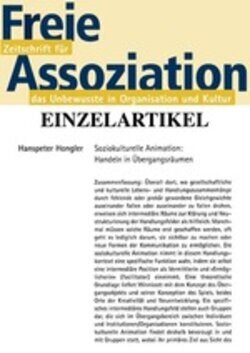20 Seiten, PDF-E-Book
Erschienen: März 2007
Bestell-Nr.: 21077
abonnieren
Hanspeter Hongler
Soziokulturelle Animation: Handeln in Übergangsräumen (PDF)
Freie Assoziation 2007, 10(1), 59-78
Sofortdownload
Dies ist ein E-Book. Unsere E-Books sind mit einem personalisierten Wasserzeichen versehen,
jedoch frei von weiteren technischen Schutzmaßnahmen (»DRM«).
Erfahren Sie hier mehr zu den Datei-Formaten.
Überall dort, wo gesellschaftliche und kulturelle Lebens- und Handlungszusammenhänge durch fehlende oder prekär gewordene Gleichgewichte auseinander fallen oder auseinander zu fallen drohen, erweisen sich intermediäre Räume zur Klärung und Neustrukturierung der Handlungsfelder als hilfreich. Manchmal müssen solche Räume erst geschaffen werden, oft geht es lediglich darum, sie sichtbar zu machen oder neue Formen der Kommunikation zu ermöglichen. Die soziokulturelle Animation nimmt in diesem Handlungskontext eine spezifische Funktion wahr, indem sie selbst eine intermediäre Position als Vermittlerin und »Ermöglicherin« (facilitator) einnimmt. Eine theoretische Grundlage liefert Winnicott mit dem Konzept des Übergangsobjekts und seiner Konzeption des Spiels, beides Orte der Kreativität und Neuentwicklung. Ein spezifisches intermediäres Handlungsfeld stellen auch Gruppen dar, die sich im Übergangsbereich zwischen Individuen und Institutionen bzw. Organisationen konstituieren. Soziokulturelle Animation findet deshalb bevorzugt in und mit Gruppen statt, wobei ihr primäres Ziel darin gesehen wird, die Handlungsfähigkeit der Gruppen dadurch zu verbessern, dass sie das dynamische Verhältnis zwischen der Entwicklung von Gruppenaufgabe und Gruppenstruktur bearbeitet.
Abstract:
Wherever the socio-cultural context of everyday life is threatening to disintegrate as a previous equilibrium has become precarious or an equilibrium is lacking altogether, intermediary spaces prove to be helpful for the clarification and restructuring of the societal fields of activity. Sometimes such spaces need to be created, more often they need to be uncovered or to enable new modes of communication. In this context, ›soziokulturelle Animation‹ can perform a specific role by itself taking an intermediary position as a mediator and facilitator. Winnicott offers a theoretical framework for the understanding of this role with his notion of the transitional object and his concept of play which can both be used to conceptualise conditions conducive to, or allowing for creativity , development of new possibilities, and growth. A specific intermediary societal field of activity are groups as they perform in the passage/transit space between individuals and institutions/organisations. Sozio- kulturelle Animation therefore prefers to work in and with groups, where, as the author will argue, it primarily aims at improving the capacity to act/operative potential in the group by attending to the dynamic relation between the development of group task and group structure.
Stichworte: Gruppendynamik, Übergangsobjekte, Organisationen, Gruppenstruktur, Kreativität, Mediation, Spiele, Psychoanalytische Theorie
Keywords: Group Dynamics, Transitional Objects, Organizations, Group Structure, Creativity, Mediation, Games, Psychoanalytic Theory
Abstract:
Wherever the socio-cultural context of everyday life is threatening to disintegrate as a previous equilibrium has become precarious or an equilibrium is lacking altogether, intermediary spaces prove to be helpful for the clarification and restructuring of the societal fields of activity. Sometimes such spaces need to be created, more often they need to be uncovered or to enable new modes of communication. In this context, ›soziokulturelle Animation‹ can perform a specific role by itself taking an intermediary position as a mediator and facilitator. Winnicott offers a theoretical framework for the understanding of this role with his notion of the transitional object and his concept of play which can both be used to conceptualise conditions conducive to, or allowing for creativity , development of new possibilities, and growth. A specific intermediary societal field of activity are groups as they perform in the passage/transit space between individuals and institutions/organisations. Sozio- kulturelle Animation therefore prefers to work in and with groups, where, as the author will argue, it primarily aims at improving the capacity to act/operative potential in the group by attending to the dynamic relation between the development of group task and group structure.
Stichworte: Gruppendynamik, Übergangsobjekte, Organisationen, Gruppenstruktur, Kreativität, Mediation, Spiele, Psychoanalytische Theorie
Keywords: Group Dynamics, Transitional Objects, Organizations, Group Structure, Creativity, Mediation, Games, Psychoanalytic Theory
Yiannis GabrielS. 7–34Das Unbehagen in Organisationen - Zu einer Theorie organisatorischen Miasmas (PDF)
Freie Assoziation 2007, 10(1), 7-34Claus-Dieter HohmannS. 35–58Die neuen Möglichkeiten des Überlebens: Flucht aus der Realität in Welten des Verlangens - Folgen für den Wettbewerb in der Automobilindustrie (PDF)
Freie Assoziation 2007, 10(1), 35-58Hanspeter HonglerS. 59–78Soziokulturelle Animation: Handeln in Übergangsräumen (PDF)
Freie Assoziation 2007, 10(1), 59-78Svenja FlaßpöhlerS. 79–92»Ich amüsiere mich bei nichts anderem« - zum Verhältnis von Arbeit und Lust bei Sigmund Freud (PDF)
Freie Assoziation 2007, 10(1), 79-92
Freie Assoziation 2007, 10(1), 7-34Claus-Dieter HohmannS. 35–58Die neuen Möglichkeiten des Überlebens: Flucht aus der Realität in Welten des Verlangens - Folgen für den Wettbewerb in der Automobilindustrie (PDF)
Freie Assoziation 2007, 10(1), 35-58Hanspeter HonglerS. 59–78Soziokulturelle Animation: Handeln in Übergangsräumen (PDF)
Freie Assoziation 2007, 10(1), 59-78Svenja FlaßpöhlerS. 79–92»Ich amüsiere mich bei nichts anderem« - zum Verhältnis von Arbeit und Lust bei Sigmund Freud (PDF)
Freie Assoziation 2007, 10(1), 79-92

